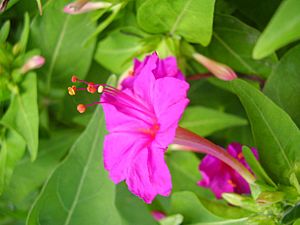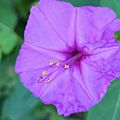Marvel of Peru facts for kids
Quick facts for kids Marvel of Peru |
|
|---|---|
 |
|
| Scientific classification | |
| Genus: |
Mirabilis
|
| Species: |
jalapa
|
The Mirabilis jalapa, often called the marvel of Peru or four o'clock flower, is a popular plant grown for its beautiful flowers. It comes in many different colors. The name Mirabilis means "wonderful" in Latin. Jalapa refers to Xalapa, a city in Mexico. Long ago, the Aztecs in Mexico grew this plant for both medicine and decoration.
These flowers usually open in the late afternoon or early evening, typically between 4 and 8 o'clock. This is how they got one of their common names. They release a strong, sweet smell all night. Then, they close in the morning, and new flowers open the next day. The plant first arrived in Europe in 1525. Today, you can find it in many warm, tropical places. It's also grown in Europe as a decorative plant, though it doesn't handle cold weather well. In Connecticut, USA, it's even the children's state flower, known as Michaela Petit's Four O'Clocks.
Contents
Why is it Called Four O'Clock?
Carl Linnaeus, a famous scientist, named Mirabilis jalapa in 1753. He chose "Mirabilis" because of the amazing colors of its flowers. The "jalapa" part might refer to its origin in Jalapa, Guatemala, or the city of Xalapa in Mexico.
Another scientist, Joseph Pitton de Tournefort, wrote about this plant in 1694. He called it "Jalap" or "Belle de Nuit," which means "Beauty of the Night." He noted that the plant's root was brought from America.
What Does the Four O'Clock Flower Look Like?
This plant is a perennial, meaning it lives for more than two years. It's also herbaceous, meaning it has soft stems, not woody ones. It grows like a bush and can reach about 1 meter (3 feet) tall, sometimes even 2 meters (6.5 feet). In colder areas, people often grow it as an annual, meaning it lives for only one year.
The seeds are round, wrinkled, and turn black when they are ready. They start out greenish-yellow. The stems are thick and have many branches.
One cool thing about the four o'clock flower is that different colored flowers can grow on the same plant at the same time! Also, a single flower can have splashes of different colors. These patterns can be whole sections of color, stripes, or spots. A single flower might be plain yellow, red, pink, or white. Or it could have a mix of these colors and patterns. Even more interesting, the patterns can be different on different flowers on the same plant.
The flowers are usually yellow, pink, and white. But you can find many other color combinations. Sometimes, the flowers even change color as the plant gets older. For example, a yellow flower might slowly turn dark pink. White flowers can change to a light purple. Even though they look like they have petals, the colorful parts are actually changed sepals, which are usually green leaf-like parts that protect the bud. The flowers are shaped like a funnel and have five lobes.
These fragrant flowers open in the late afternoon or early evening. They also open on cloudy days. They smell a bit like tobacco flowers and attract moths for pollination. The flowers stay open for about 16 to 20 hours. Long-tongued moths, like sphinx moths, are attracted to the smell and help pollinate the plant.
How to Grow Four O'Clocks
This plant grows best in full sun. Sometimes, the leaves might wilt in strong sun, but they usually perk up in the evening when it gets cooler. Four o'clocks don't like cold weather. The parts of the plant above ground can die with the first frost. However, the roots underground can survive and grow new plants in the spring. The plant often drops its own seeds and can spread quickly in a garden if you don't keep an eye on it. Some gardeners suggest soaking the seeds before planting, but it's not always necessary. In warm, coastal parts of North America, the plant can grow back year after year. It's an easy plant to grow as long as it gets enough sun or partial shade. It grows very fast in these conditions.
Four o'clocks prefer light soil that is rich in humus (decayed plant matter) and drains water well. The soil should be neutral in acidity (pH). You can also grow them in pots. Use a mix of 80% soil and 20% garden soil in a deep pot. Plant the roots about 10 cm (4 inches) deep. You can usually plant the seeds from mid-February to May. The seeds sprout quickly at about 18 °C (64 °F).
Where Does the Four O'Clock Flower Grow?
Mirabilis jalapa originally comes from the dry tropical areas of North, Central, and South America. This includes countries like Mexico, Guatemala, Chile, and Peru. People have planted this flower for decoration all over the world. Now, it grows naturally in many tropical, subtropical, and temperate regions. You can find it in countries in Asia, Africa, the United States, the Middle East, and Europe.
For example, on Réunion island, it was first an ornamental plant. But now it grows wild in many areas. It can grow in places with lots of debris and is common in weedy sugarcane fields. It produces many seeds and grows fast, sometimes covering a large part of the fields. In cooler subtropical and temperate areas, it dies back when the first frosts arrive. But it regrows in the spring from its tuber-like roots.
Flower Colors and Genetics
Around 1900, a scientist named Carl Correns studied Mirabilis to learn about how traits are passed down. He used the plant's colorful leaves to show that some things outside the main cell part (the nucleus) can affect how a plant looks. This was different from what Gregor Mendel had found. Correns suggested that leaf color in Mirabilis was passed down from only one parent.
Another interesting thing happens when you cross plants with dark-pink flowers with plants that have white flowers. The new plants will have light-pink flowers! This is an example of something called incomplete dominance. It means that neither the dark-pink gene nor the white gene is completely stronger than the other. They mix to create a new color. However, Mendel's rules about how traits separate in later generations still apply, which shows how important his discoveries were.
Cool Uses for the Plant
- The flowers are used to make food coloring. The leaves can also be cooked and eaten, but only if there's no other food available.
- A red dye can be made from the flowers to color cakes and jellies.
- In traditional medicine, parts of the plant are used to help heal wounds. It's also used to treat swelling.
- The leaves are used to reduce swelling. A decoction (a liquid made by mashing and boiling) of the leaves is used for boils. The juice from the leaves can be used on wounds.
- The powdered seeds from some types of the plant are used as a cosmetic and a dye. However, the seeds are considered poisonous, so be careful!
- This plant can help clean up soil that has too much heavy metal, like cadmium.
- In Brazil, the Kayapo people sniff the powder from dried flowers to help with headaches. They also use a root mixture to wash wounds and treat skin problems like leprosy. In Peru, flower juice is used for herpes and earaches. Root juice is used for earaches, diarrhea, and liver infections. In Mexico, mixtures from the whole plant are used for infections, and bee and scorpion stings.
- The flower extract can be used as a natural pH indicator in science experiments to test if something is an acid or a base. Scientists found this method to be cheap and accurate.
- People have used M. jalapa in the Himalayas for a very long time, showing it was brought there a long time ago.
Gallery
Common Names Around the World
The four o'clock flower has many interesting names in different languages:
- In Greece it's called "Nychtolouloudo" (Νυχτολούλουδο), meaning “night flower,” and "Deilina" (Δειλινά), meaning “sunsets.”
- In Maldives it's called "asurumaa," meaning a flower blooming at "Asr," which is a prayer time in the afternoon.
- In Bangladesh it's called sandhyamalati (Bengali: সন্ধ্যামালতী), meaning "evening flower."
- In Pakistan it's called gul adnan (Urdu: گل عدنان) or gul-e-abbas (Urdu: گل عباس).
- In West Bengal it's called sandhyamoni (Bengali: সন্ধ্যামণি), meaning "evening gem."
- In Sri Lanka it's called hendirikka (Sinhala: හෙන්දිරික්කා).
- In Karnataka it's called sanje mallige (Kannada: ಸಂಜೆ ಮಲ್ಲಿಗೆ).
- In Tamil Nadu it's called andhi mandhaarai (Tamil: அந்தி மந்தாரை).
- In Thailand it's called bānyĕn (Thai: บานเย็น), meaning "evening blossom."
- In Andhra Pradesh it's called "chandrakantha"(Telugu: చంద్రకాంత), meaning "moon light," because it blooms when the moon rises.
- In Bulgaria it's called noshtna krasavica (Bulgarian: нощна красавица), which means "night beauty."
- In Germany it's called Wunderblume, which means "flower of miracle."
- In Kerala it's called naalumani poovu (Malayalam: നാലുമണിപ്പൂ, പതിറ്റടിമുല്ല), which means "four o'clock flower."
- In Maharashtra it's called gulabakshi (Marathi: गुलबक्षी).
- In Assam it's called godhuli gopal (Assamese: গধূলিগোপাল), godhuli meaning "evening."
- In Maithili it's called sanjhaa phool as it blooms in the evening.
- In Odisha it's called rangani (Odia: ରଂଗଣୀ).
- In Punjabi it's called sham di sohnap, which means "evening beauty."
- In Indonesia it's called bunga pukul empat.
- In Malaysia it's called seroja.
- In China it's called the "shower flower" (Chinese: 洗澡花; pinyin: xǐzǎo huā) or "rice boiling flower" (simplified Chinese: 煮饭花; traditional Chinese: 煮飯花; pinyin: zhǔfàn huā) because it blooms when people do these activities.
- In Hong Kong it's known as "purple jasmine" (Chinese: 紫茉莉; pinyin: zǐ mòlì).
- The Turkish name is akşam sefası, which means "evening pleasure."
- In the Netherlands and in France the name of the plant is nachtschone and belle de nuit respectively, both meaning "beauty of the night."
- In Italy it's called bella di notte, which means "beautiful during night."
- In Iran it's called laleh abbasi (Persian: لاله عبasi).
- In Japan it's called oshiroi-bana (Japanese: オシロイバナ), because the white, powdery inside of the seeds looks like oshiroi, a traditional Japanese face powder.
- In Israel it's named lilanit rav-gonit (Hebrew: לילנית רב-גונית), and more commonly called malkat halayla (Hebrew: מלכת הלילה), meaning "queen of the night."
- In Namibia it's called vieruurtjie ("four o'clock") as it starts to open at 4:00 PM.
- In Poland it's called dziwaczek, meaning "a little weirdo," referring to its unusual flowering time.
- In Slovenia it's called nočna frajlica, meaning "night missy."
- In Croatia and Serbia it's called noćurak (Serbian: ноћурак).
- In Romania it's called frumoasa nopții, meaning "the beauty of the night," or also noptiță.
- In the Philippines it's called prinsesa ng gabi, meaning "princess of the night," or sometimes alas quatro, "at four o'clock."
- In Mexico and Cuba it's called maravilla, meaning "marvel."
- In Malta it's called ħummejr.
- In Russia it's called zor'ka (Russian: зорька), meaning "dawning."
- In Syria it's called alshab alzarif (Arabic: الشاب الظريف) meaning "the charming young man."
- In Ukraine it's called nichna krasunya (Ukrainian: нічна красуня), meaning "night beauty."
- In Colombia it's called Don Diego de noche, meaning "Mr. Diego of night."
- In Lebanon it's called shab el layl (Arabic: شاب الليل), meaning "young man of the night."
- In Uttarakhand it is called "गुल बांक" Gul baank.
See also
 In Spanish: Dondiego de noche para niños
In Spanish: Dondiego de noche para niños













